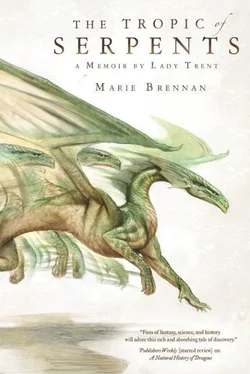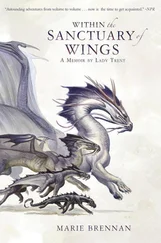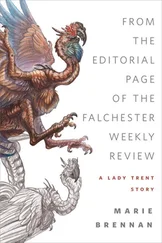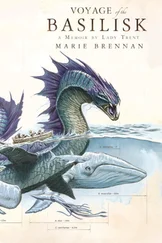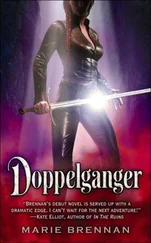He shook his head at the sight of her. “I would ask whether you have any notion what you’ve just done. But you’re the earl’s granddaughter, and I know you’ve inherited at least a portion of his intelligence. So I will only ask you, in God’s name, why. ”
“Because I had to,” Natalie said.
I understood her meaning, but Mr. Wilker clearly did not. Yet we required some degree of comity, or this expedition would be doomed before we arrived in Nsebu. “Mr. Wilker. I am sure you endured hardships of your own, gaining your education, forcing those of higher station to accept you as their intellectual peer. Why did you do it?”
“This will rebound on her family,” he said, ignoring my question.
“And were there no consequences for your own family, when you left Niddey for university?”
It was a guess, but not a blind one; I knew Mr. Wilker was the eldest son of his line. His indrawn breath told me I had struck my mark. Belatedly—as usual for me, I regret to say—I wondered whether his sensitivity on this matter was because of his own experience, rather than in spite of it.
“When you came to Vystrana, it was different,” he said, as if appealing to me for reason. “You came with Jacob, and with his blessing.”
“Are a woman’s wishes only fit to be considered when blessed by a male relative?” I asked sharply. “If so, then take Lord Hilford’s for Natalie, and let us be done with it.”
He flushed, and left soon after. It was not the last time we argued the matter, but my words had lodged under his skin like a barb, and their effect became apparent in due course.
In which we arrive in Eriga, where we achieve both success and scandal, and embroil ourselves in various conflicts
Sea-snakes—The port of Nsebu—Faj Rawango—Half-naked men—Nsebu and Atuyem—We are no threat
Even at the reliable pace of a steamer, the journey to Nsebu was not short. We stopped in various ports for trade; we battled foul weather; once three boilers broke down in concert, and the Progress made no progress at all until they were repaired. We were at sea for a month altogether, and to alleviate my boredom (for we soon completed the plans for our research, and there are only so many hands of whist one can play without going mad) I began observing the sea life.
Fish and whales, sharks and seabirds; the latter held the most interest for me, as I had not lost my childhood partiality toward wings. But despite its lack in that regard, I was most captivated by the great sea-snake we saw one afternoon near the end of our voyage.
We were entering Erigan waters, crossing the latitude known as the Tropic of Serpents, so named for the large numbers of sea-snakes found there. This was the only one we got a good view of, and all the passengers (and half the crew) crowded to the rails to observe it. “People argue about whether they should be considered dragons,” I said to Natalie, watching the great coils rise above the water’s surface and slip away once more. “Your grandfather doesn’t believe the Prania sea-snakes should be, but I wonder about these beasts. There are so many creatures around the world that seem partially draconic in nature, but they lack wings, or forelimbs, or extraordinary breath. I think sometimes that Sir Richard Edgeworth’s criteria may be wrong—or rather, too strict.”
“Another thing to study,” Natalie said, amused. “Will you ever be done?”
I smiled into the sun, one hand holding my bonnet against the firm grasp of the wind. “I should hope not. How dreadfully tedious that would be.”
* * *
Four days later, with all the passengers lined up at the rail once more, the Progress steamed past the rocky outcrop of Point Miriam and into the deep harbor of Nsebu.
Because the geography of this region will be of great relevance later, I should take a moment to describe it now. The land of Bayembe lies on the northern side of the Bay of Mouleen, mostly along a plateau lifted above sea level, but beneath the mountains that form their northern border with the Talu Union. Their eastern border and part of the southern are ocean; the rest was, at the time, the disputed territory between the Girama and Hembi rivers, and the edge of the great, sunken swamp of Mouleen, whose streams spill into the bay at a thousand points.
Mouleen is born from an eccentric quirk of geology. It would, in the normal way of things, be a great river delta, as the Girama, the Gaomomo, and the Hembi converge only a few hundred kilometers inland, the culmination of their long rush to the sea. But a fault in the underlying rock dropped the region nearly to sea level at what should have been the confluence, with the result that all three rivers tumble over a cliff and drown the land below. Furthermore, the prevailing winds at that latitude blow from the east, funneling much of the atmospheric moisture into the low channel formed by that geologic fault, and therefore much of the rain. The resulting morass is the impenetrable jungle of Mouleen—more colloquially known as the Green Hell.
But that was not yet my destination. Although I spared a few glances for the emerald band that marked the western edge of the bay, the bulk of my attention was on the town perched just off its corner, over which the fort at Point Miriam stood guard.
Neither words nor images suffice to communicate what greeted me as we came into port, for even the best artwork is a static thing of the eye alone, and words are by their nature linear. I can tell you of the smells that assaulted my nose: the salt sea, the coal smoke of other steamers, the fish and shellfish that even today make up a brisk part of the port’s local trade, the spices whose aromatic vibrancy is all out of proportion to their quantity. Unwashed bodies and tar, fresh-cut tropical lumber, the greasy stench of lunch being fried for dockworkers and hungry travellers alike. But I can only tell you of one scent at a time, and I cannot present those to you at the same time as I give you the sounds and the sights, the mad clamour that was my first experience of Eriga.
With the knowledge I have now, I can give the proper names to what I saw then only as a bewildering array of peoples. There were Scirlings among them, of course, merchants and soldiers, there to protect our interests in iron production. Nor were we the only Anthiopeans, despite tensions with our rivals over their involvement elsewhere in Eriga; there were Thiessois, Chiavorans, a cluster of Bulskoi looking exceedingly uncomfortable in the heat. Pigtailed Yelangese bustled around their ships, and Akhians were nearly as common as Scirlings.
But it was the Erigans who dazzled my eye, for they were new to me, and formed the bulk of the crowds.
Amongst themselves, they displayed a hundred different modes of dress and adornment, a hundred different details of physiognomy that mark one people as distinct from another. I saw complexions ranging from inky blue-black to bronze, mahogany, and dark amber, sharp chins and square jaws, high foreheads and low, full lips and wide mouths and cheekbones that rode flat or stood out like the arches of a bow. The people wore their hair in loose braids or braids close to the scalp, in beads or strips of fabric, in soft clouds and corkscrew curls and sharp ridges held in place by white or red clay. There were Agwin veiled from head to toe and Menke in little more than loincloths, Sasoro in silver and Erbenno in embroidery, Mebenye and Ouwebi and Sagao and Gabborid in variations on the folded wrap, whose subtleties of color and arrangement communicate a great deal to the knowledgeable eye, but escaped my understanding entirely that first day. And, of course, there were countless Yembe, the dominant people of that land.
Читать дальше
